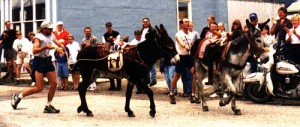Letter from Jim Scanga
Nutrition – March 2004 – Colorado Central Magazine
[Editor’s note: Jim Scanga called to share some thoughts he had regarding Hal Walter’s recent column, “A Regional Answer to the Food-Supply Questions.” Upon realizing that Jim had much to say on this issue, we asked him to write a letter to the magazine and he agreed. Thank you, Jim, for this thought-provoking rebuttal.]
Thousands of cattle are calved and raised in Central Colorado each year. Most are sold at auction for either breeding stock or to be finished on corn and grain products in feedlots. Regional ranchers have known for decades that trying to market their animals directly to consumers would not only be a merchandising challenge but also an inefficient enterprise considering the low volume of animals that a rancher can sell in this manner. After all, selling directly to the consumer would create a whole new business with a whole different set of problems.
“Farm to table” is a wonderful idea but making it work in the real world for all parties concerned is a different story. At Scanga Meat, we have a few customers who market their animals in this manner but this only represents a fraction of their yearly income. It’s simple: they easily satisfy a small demand for their particular product. But there are only a few people, in comparison to the great majority, who are willing to pay more for family-farm produced products. If this were not true, chain store meat departments, instead of flourishing, would be out of business.
For the most part, meat from corn-fed animals is more palatable and tender than range-fed beef. It also costs more to finish an animal on corn rather than on grass or hay. And nutritional values of grass-fed meats versus corn-fed meats are so infinitesimally small — if one is familiar with factual research in this area — that it does not even warrant discussion. So if corn-fed meat actually was inferior in quality or flavor, corporate feedlots or feedlots in general would not exist.
Furthermore, cattle who are fed corn are no more susceptible to BSE than those on a grass diet and to entertain such an idea is just blind ignorance! Elk and deer that roam freely in northern Colorado feast on natural grasses and drink pristine water from mountain streams. But these “wild animals,” and their domesticated relatives, have fallen victim to CWD (chronic wasting disease), which is as serious and as indestructible as BSE (Bovine spongiform encephal opathy) or “mad cow” disease. Both are part of the same family of TSES (transmissible spongiform encephalopathies).
For years wild animals in Colorado have tested positive for CWD. No one knows for sure how these creatures became infected or the origins of this particular killer. But one thing is certain, the problem, at least for the wild animals, has nothing to do with corn or feedlots!
In my 30 years of experience in the meat industry, I have learned that raising animals 100% “naturally” does not guarantee a quality product or a wholesome product.
Throwing science “out the window” is just not a good idea. When it comes to animal rearing and food production, a certain amount of people clamor for the industry to go back in time to the “good old days.” But imagine the 21st century with 19th-century science. In almost any other facet of society this sounds and is ludicrous. A proper balance of common sense, science, and ethics goes a long way in the food business whether it is on the ranch or in food production and marketing.
On the other hand some products labeled “natural or organic” are a better choice for a quality product — as long as the merchant is not inflating prices in an effort to take advantage of uninformed customers. The general public knows when something is of poor quality and will only buy it once.
A good general rule is to read product labels or talk to the person behind the counter or the owner of the market. If something is too much of a bargain, chances are it is something that you do not want on your table. It doesn’t take a food scientist to realize that a salmon labeled “red coloring added” or “this product contains imitation shrimp” is not something that one would want to bring home.
Jim Scanga
Salida



